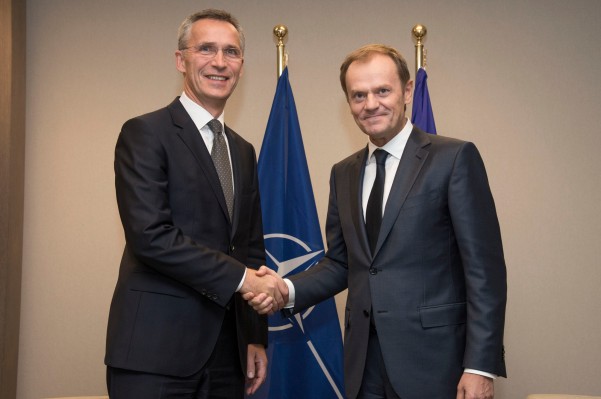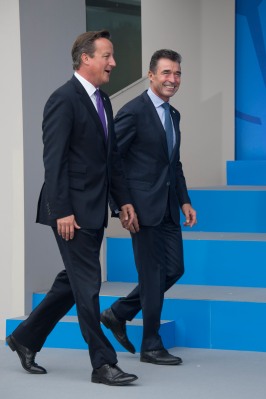The NATO Very High Readiness Joint Task Force (VJTF)
On December 2, 2014, NATO restated its intention to develop an “Interim Rapid Response Force” of brigade size, starting January 1, 2015. NATO chiefs reviewed the progress made on the commitment to the Readiness Action Plan and Wales Summit Declarations of September 2014, pledging to expand NATO’s joint Response Force (NRF), the combat component of which is the Immediate Reaction Force (IRF), and commit to reverse falling defence spending amongst member-states.[i]
On 3 December NATO Secretary General Jens Stoltenberg met with the new President of the European Council (EC), Donald Tusk, at the EC HQ in Brussels. The two reiterated plans for closer cooperation on defence, in particular, mutual defence against possible Russian aggression.[ii]
NATO Secretary General Jens Stoltenberg meets with the new President of the European Council (EC), Donald Tusk on 3 December 2014.[iii]
This new international brigade will compliment other NATO and European assets focused primarily on Air & Sea power, such as the NATO Reaction Force.[iv]
The new NATO ground force has been seen as a component of the larger NATO reaction to the ongoing crisis in Ukraine, triggered after the Russian military takeover of the Crimean peninsula.[v]
Broader NATO strategy for Russia includes the re-militarization of Ukraine: On 3 September 2014, Ukrainian Prime Minister Arseniy Yatsenyuk stated that the Ukrainian economy was successfully mobilizing. A new National Guard had been created.[vi] Ukraine’s new government plans to increase its defence spending from 1% to 5%. Current Ukrainian military intentions are outlined in the Strategy 2020 document.[vii]
Organizational Structure of NATO showing Immediate Reaction Forces alongside standing naval forces and air commands, such as the Reaction Force (Air) Staff, HQ located in Kalkar, Germany.[viii]
NATO Response Force
In 1999 the Common Security and Defence Policy of the EU was outlined.[ix] By 2000 NATO non US Ally defence spending was falling from the average 2.0% of GDP.[x] In 2001 the United States provided 63% of NATO’s defence budget.
The NATO Response Force was first announced at the Prague Summit in 2002 November.[xi] The NRF was declared operational on 13 October 2004 at the Poiana Brasov, Romania, meeting between NATO Secretary General Jaap de Hoop Scheffer of the Netherlands and Supreme Allied Commander Europe General James L. Jones USMC.[xii]
As of October 2014 the NRF was composed of three branches: a Command & Control branch, “the Immediate Response Force [IRF], a joint force of around 13,000 high-readiness troops” and a general pool to supplement the IRF.[xiii] The IRF is composed of: a land brigade of three battle groups with support, maritime components from the Standing NATO Maritime Group (SNMG) and Standing NATO Mine Countermeasures Group (SNMCMG), a combat air component and support, special operations forces, and a chemical, biological, radiological and nuclear defence task force.[xiv] Until January 2015 France’s NATO Rapid Reaction Corps (HQ, Lille) provides the land-based component of the NRF.[xv]
29 October 2013, French and NATO soldiers train at Harskamp, Holland, in preparation for the 2014 NRF rotation.[xvi]
Member nations contribute land, air, maritime and special forces to the IRF for what were initially 6 month terms but as of 2012 are 12 months.[xvii] Finnish F/A-18 pilots took part in the NRF 2014 rotation.[xviii] The NRF represents a benchmark for international cooperation between combat forces. Operational command moves between Brunssum, Holland and Naples, Italy.
A major short fall for the NRF has been air-to-air refueling. Europe fields about 40 air refueling tankers, compared to the 550 fueled by the USAF. The European Defence Agency (EDA) carried out air-to-air refueling trials in the Netherlands between 31 March and 11 April 2014 in cooperation with the European Air Transport Command.[xix]
The European Defence Agency (EDA)
The NRF was created as part of a series of reforms including the creation in 2004 of the European Defence Agency.[xx] The EDA reports to the Council of the European Commission. The EDA mainly organizes international training operations, for example, from September 17 to 5 October 2012 the EDA Belgian Air Component hosted the Green Blade exercises involving helicopter troop operations, supported by F-16s.[xxi] Three major events involving air crews have been organized during 2014.[xxii] Nevertheless, the EDA’s efforts are generally focused on air and seapower, highlighting what some analysts describe as a “defence deficit” between capability and scalability.[xxiii]
NATO forces operating abroad before the Iraq war in 2003.[xxiv] During the 1990s and 2000s the NATO nations generally froze conscription, transitioning to all volunteer forces.[xxv] By 2014 United States share of total NATO Defence spending has risen to 72%.[xxvi]
NATO VJTF
The new NATO Very High Readiness Joint Task Force (VJTF) was first announced on 29 August 2014 by NATO Secretary General Andres Fogh Rasmussen[xxvii] and was reinforced by Britain’s PM David Cameron at the 4-5 September NATO (Wales) summit.[xxviii] NATO Supreme Allied Commander General Phillip Breedlove discussed the functions of the new VJTF on 27 October 2014 (see interview).[xxix]
UK Prime Minister David Cameron and former NATO Secretary General Anders Fogh Rasmussen arrive at the Wales Summit, 4 September 2014.[xxx] The NATO Summit resulted in the publication of the Wales Summit Declaration, pledging NATO members to reverse declining defence budgets.[xxxi]
In the 2 December 2014 announcement it was stated that the “‘interim spearhead’ force will be made up of German, Dutch and Norwegian troops” between 3,000 and 4,000 strong.[xxxii] The VJTF will primarily consist of “a land component with appropriate air, maritime and Special Operations Forces available.”[xxxiii] According to NATO Secretary-General Jens Stoltenberg, the “interim force” which will become operation on 1 January 2015, is expected to be replaced by a “permanent” force sometime in 2016.[xxxiv] NATO Defence Ministers will arrange the new “spearhead force” size and function in February 2016.[xxxv]
Conclusion
Britain, as of 1 September 2014, also plans to prepare a separate 10,000 strong Joint Expeditionary Force.[xxxvi]
Despite the refocus on European and NATO military capability, “Europe continues to lack the ‘key enablers’ – air-to-air refueling capacity, intelligence surveillance and reconnaissance and satellite communications.”[xxxvii]
Non US Defence spending amongst NATO member-states has dropped from 1.5% in 2007, although current US Defence Spending has not significantly increased since 2007, floating between $650 billion in 2007 to $635 billion in 2014.[xxxviii]
Recent Developments in Ukrainian Crisis
As of 2 December, the US had committed $118 million to the government in Kiev.[xxxix] Currently Russian debt valued at $700 billion is owed to Western banks.[xl] The Russian economy is expected to enter a recession in 2015.[xli] On 1 December 2014 Ukraine described attacks by Russian special forces against the Donetsk airport. [xlii]
[i] North Atlantic Treaty Organization, “Statement of Foreign Ministers on the Readiness Action Plan,” NATO, December 2, 2014, http://www.nato.int/cps/en/natohq/official_texts_115551.htm. https://www.gov.uk/government/uploads/system/uploads/attachment_data/file/351406/Wales_Summit_Declaration.pdf
[ii] North Atlantic Treaty Organization, “Secretary General: NATO and the European Union Are Stronger Together’’,” NATO, December 3, 2014, http://www.nato.int/cps/en/natohq/news_115652.htm.
[iii] http://www.nato.int/cps/en/natohq/photos_115298.htm
[iv] North Atlantic Treaty Organization, “NATO Response Force,” NATO, October 2, 2014, http://www.nato.int/cps/en/natohq/topics_49755.htm.
[v] Alexander Howlett, “Russian Operational Art of War in Crimea, March 2014,” blog, Airspace Historian, (November 5, 2014), https://airspacehistorian.wordpress.com/2014/11/05/russian-operational-art-of-war-in-crimea-march-2014/.
[vi] Globalsecurity.org, “Ukraine Defense Doctrine” (Globalsecurity.org, November 5, 2014), http://www.globalsecurity.org/military/world/ukraine/doctrine.htm.
[vii] Ibid.
[viii] http://en.wikipedia.org/wiki/Military_units_and_formations_of_NATO
[ix] Anand Menon, “Confronting Europe’s Defence Deficit,” European Defence Matters, p. 18
[x] Anand Menon, “Confronting Europe’s Defence Deficit,” European Defence Matters, 2014. p. 17
[xi] North Atlantic Treaty Organization, “NATO Response Force.”
[xii] Wikimedia Foundation, “List of NATO Secretaries General,” Wikipedia, the Free Encyclopedia, November 30, 2014, http://en.wikipedia.org/w/index.php?title=List_of_NATO_Secretaries_General&oldid=633802724., Wikimedia Foundation, “Supreme Headquarters Allied Powers Europe,” Wikipedia, the Free Encyclopedia, December 1, 2014, http://en.wikipedia.org/w/index.php?title=Supreme_Headquarters_Allied_Powers_Europe&oldid=635289410.
[xiii] North Atlantic Treaty Organization, “NATO Response Force.”
[xiv] Ibid., http://www.nato.int/cps/en/natolive/topics_49755.htm?selectedLocale=en
[xv] North Atlantic Treaty Organization, “The Headquarters of the Rapid Reaction Corps, Based in Lille, France, Prepares for the 2014 Rotation of the NATO Response Force,” NATO, October 29, 2013, http://www.nato.int/cps/en/natohq/photos_104586.htm.
[xvi] http://www.nato.int/nato_static_fl2014/assets/pictures/2013_10_131028b-rrc/20131029_131028b-02.jpg
[xvii] North Atlantic Treaty Organization, “NATO Response Force.”, http://www.nato.int/cps/en/natolive/topics_49755.htm?selectedLocale=en
[xviii] Lauri Tapio Puranen, “Finnish Air Power: In Defense of the Homeland,” in European Air Power, ed. John Andreas Olsen (Lincoln, NE: University of Nebraska Press, 2014), 185–98. p. 189
[xix] Editorial, “Building Trust for Multinational Operations,” European Defence Matters, 2014. p. 28
[xx] European Defence Matters – The Role of the European Defence Agency, 2013, https://www.youtube.com/watch?v=VK7oHT6dEhc&feature=youtube_gdata_player.
[xxi] Green Blade 2012, 2012, https://www.youtube.com/watch?v=j1LIb7aF6G8&feature=youtube_gdata_player.
[xxii] Editorial, “Building Trust for Multinational Operations.” p. 28
[xxiii] Menon, “Confronting Europe’s Defence Deficit.”, p. 16
[xxiv] Table 2: Forces of NATO Countries Operating Abroad in 2003, Cindy Williams, “From Conscripts to Volunteers: NATO’s Transitions to All-Volunteer Forces,” Naval War College Review 58, no. 1 (Winter 2005): 35–62. p. 40
[xxv] Table 1: Conscription Policies in NATO countries. Ibid., p. 37
[xxvi] Menon, “Confronting Europe’s Defence Deficit.” p. 17
[xxvii] The 12th Secretary General of NATO, Denmark’s Andres Fogh Rasmussen was succeeded by the former Prime Minister of Norway, Jens Stoltenberg on 1 October 2014, part of an arrangement made at the end of the March crisis:
[xxviii] Reuters, “Seven NATO Allies Will Reportedly Create New Rapid Reaction Force,” Www.huffingtonpost.com, August 29, 2014, online edition, http://www.huffingtonpost.com/2014/08/29/nato-rapid-reaction-force_n_5738800.html.
[xxix] US Defence Department, “NATO’s Very High Readiness Joint Task Force,” October 27, 2014, http://www.defense.gov/video/default.aspx?videoid=369311.
[xxx] http://www.nato.int/cps/en/natohq/photos_112410.htm
[xxxi] https://www.gov.uk/government/uploads/system/uploads/attachment_data/file/351406/Wales_Summit_Declaration.pdf, see also http://www.gov.uk, “The Wales Declaration on the Transatlantic Bond – GOV.UK,” September 5, 2014, https://www.gov.uk/government/publications/nato-summit-2014-wales-summit-declaration/the-wales-declaration-on-the-transatlantic-bond.
[xxxii] Michael R. Gordon, “Nimble New NATO Force to Take Form Next Year,” The New York Times, December 2, 2014, Online edition, sec. Europe, http://www.nytimes.com/2014/12/03/world/europe/nato-to-create-interim-rapid-response-force-to-counter-russia.html?_r=0.
[xxxiii] North Atlantic Treaty Organization, “NATO Response Force.”
[xxxiv] John-Thor Dahlburg and Lara Jakes, “NATO Steps up to Russia, but Back from Afghanistan,” The Associated Press, December 2, 2014, online edition, sec. News, https://news.yahoo.com/nato-ministers-condemn-russia-support-ukraine-135248663.html.
[xxxv] North Atlantic Treaty Organization, “NATO Foreign Ministers Announce Interim Spearhead Force,” NATO, December 2, 2014, http://www.nato.int/cps/en/natohq/news_115552.htm.
[xxxvi] Ewen MacAskill, “Nato to Create High-Readiness Force to Counter Russian Threat,” The Guardian, September 1, 2014, Online edition, sec. World news, http://www.theguardian.com/world/2014/sep/01/nato-high-readiness-spearhead-force-counter-russian-threat.
[xxxvii] Menon, “Confronting Europe’s Defence Deficit.” p. 18
[xxxviii] http://www.usgovernmentspending.com/year_spending_2007USbn_16bs2n_30#usgs302
[xxxix] Dahlburg and Jakes, “NATO Steps up to Russia, but Back from Afghanistan.”
[xl] Andrew Kramer and Neil MacFarquhar, “With Russia on Brink of Recession, Putin Faces ‘New Reality,’” The New York Times, December 2, 2014, Online edition, sec. International Business, http://www.nytimes.com/2014/12/03/business/russia-forecasts-a-recession-in-2015-signaling-a-toll-from-sanctions-and-oil-prices.html?contentCollection=world&action=click&module=NextInCollection®ion=Footer&pgtype=article.
[xli] Alexander Zemlianichenko, “Russia Will Hit Recession in 2015 because of Oil and Ukraine, Kremlin Admits,” News, Cbc.ca, (December 3, 2014), http://www.cbc.ca/1.2857186.
[xlii] Reuters, “Ukraine Says Russian Special Forces Involved in Attacks on Airport in East,” Reuters, December 1, 2014, Online edition, http://www.reuters.com/article/2014/12/01/us-ukraine-crisis-military-idUSKCN0JF1ZN20141201.






